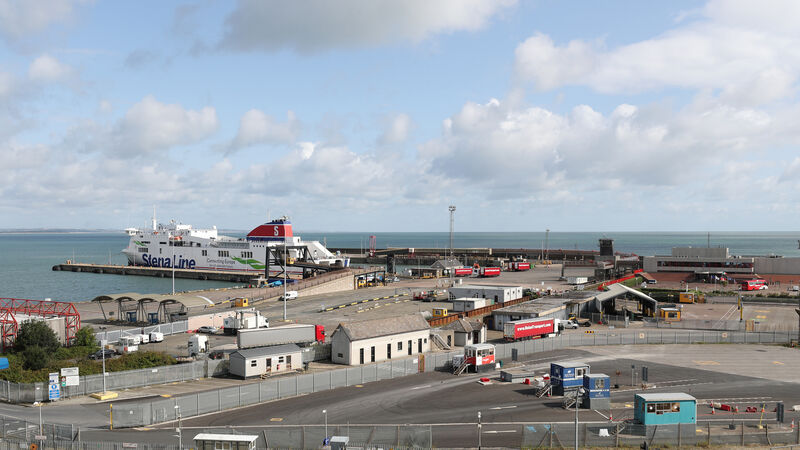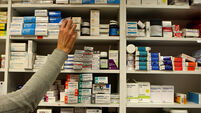'Struggling to breathe': Migrants found in Rosslare cut air hole in ship container

A general view of Rosslare Europort in Co Wexford, Ireland.
The 14 people rescued from a refrigerated container at Rosslare Europort had to cut a hole in the side of the container as they were struggling to breathe, Wexford first responder Ger Carthy has said.
Two children and 12 adults were discovered hidden within a refrigerated trailer on board a lorry arriving at Rosslare Europort on Monday.
Mr Carthy, a first responder and an independent county councillor, said one of the migrants had raised the alarm by calling the UK’s 999 service which diverted the call to Ireland and emergency services were at the port when the ship docked.
The people in the container were assessed and cared for at the scene and then transferred to a processing centre in Dublin where translation services were provided, he said.
A Garda source confirmed that those on board the trailer were primarily Kurdish nationals.
Mr Carthy said it had been “quite a challenging and very dangerous trip for anyone to make” and it was very fortunate that there had not been an outcome similar to a previous occasion when a number of people died in a container that arrived in Rosslare.
He said a disaster had been averted, but it highlighted the desperation of people coming from “possibly war-torn countries, trying to get to a better way of life”, that they would board a ship in a container.
Mr Carthy added that the 14 people had thought they were going to the UK.
The container in which they were found was a refrigerated roll-on roll-off. They had been in it for 28 hours when the 999 call was made.
The journey was 30 hours, which gave emergency services time to get in place for their arrival, he explained.
The increase in sailings to Rosslare, post-Brexit, meant that there could be more such incidents, he said.
“We're going to have more and more of that. But we have a very robust immigration system. I suppose that it should alert the government that we're going to see more and more of this, though, with the current crises across the world.”

Transport Minister Eamon Ryan said people are making the crossing because they are desperate and Ireland has obligations under international law to provide refuge where appropriate.
“We have to do everything we can to try and avoid such carriage and passage because it is dangerous and a risk to the lives of those who are put on or go on to those trucks.
“We have to do what we can to reduce it but you cannot completely eliminate it. We’ve seen that with the UK Government and France, trying to stop that passage.
“It is practically impossible to completely avoid it.”
The president of the Irish Road Haulage Association, Eugene Drennan, said the container in which the 14 people travelled would have been fully sealed and the migrants would have required assistance to get into it by someone who knew how to manipulate the locks and seals.
It had been “a stroke of luck” that there were no fatalities, he said.
The Irish company that owned the container was a long-established family firm, he said.
The truck was loaded south of Paris, the driver then took a mandatory break at a service area north of Paris, after which he conducted his checks.
“So these people were put on board by a very professional gang that had to help because the truck was fully sealed. It's a solid site, a trailer. It was a refrigerated trailer. So access is through the back doors or through the roof," he told .
Mr Drennan said the people may have thought the truck was going a shorter route from Calais to Dover, but in fact, it was going to Zeebrugge and from there, directly to Rosslare.
The container was refrigerated, running intermittently to save fuel and carbon emissions.
Migrants do not know one trailer from another, but the people who put them on board would have known, which was hugely worrying, said Mr Drennan.
When asked who had responsibility in this situation, Mr Drennan said that such gangs were visible and the French authorities “could do more”, but that it was difficult to point fingers.
It was difficult for drivers, who had conducted the checks, he said.
"In this case, the man had been in his bed asleep, he was alone. He had conducted the necessary protocols and checks. But even in ports where there was specialised equipment people were still able to get through, sometimes in compartments or in the chassis," he said.
“They're very sophisticated checks and they're still on board.”
When asked if there should be cameras inside a container for the drivers to monitor, Mr Drennan said that drivers were already trying to drive the vehicle and could not do so safely, and monitor cameras.
“And you must remember a driver is very much on his own. In the dark of the night, along the coastline of northern France and Belgium. It's not an easy place to be solo and have quite a number of very hungry people trying to get out.”










